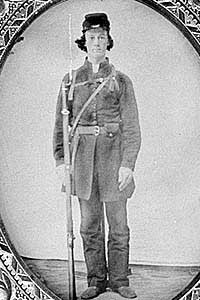The American Civil War, a conflict often visualized in contrasting colors, immediately brings to mind the blue-clad Union soldiers and their gray Confederate counterparts. While this color dichotomy is broadly accurate, the reality of uniforms, especially in the early days of the war, was far more nuanced. This article delves into the specifics of Southern Civil War Uniforms, exploring their evolution, materials, and distinctive characteristics.
Initially, the Confederate army presented a diverse array of clothing styles. Many soldiers arrived in outfits they brought from home, leading to a patchwork appearance within units. Furthermore, local militia groups, already equipped with their own uniforms, readily adopted them for Confederate service. Interestingly, this meant some Confederate troops were initially seen wearing blue, mirroring the confusion on the Union side where some units sported gray. Adding to the visual complexity, certain groups, inspired by the French Zouaves of North Africa, favored flamboyant attire, including baggy, brightly colored trousers—often red or striped—and fez or turban-style headwear.
However, as the war progressed, a degree of standardization emerged for southern civil war uniforms. The most recognizable Confederate uniform consisted of a gray kepi, jacket, and trousers. This gray hue, though intended to be uniform, was susceptible to the elements. Exposure to weather and the rigors of campaigning caused the gray fabric to fade and weather, often taking on a light brownish tint. This transformation gave rise to the enduring nickname “Butternuts” for Confederate soldiers, referencing the pale brown color of butternut dye, a common natural dye used for homespun fabrics. Indeed, “butternut” brown clothing might also have originated from these simpler, homespun uniforms, reflecting the Confederacy’s resourcefulness and the blockade’s impact on supply chains.
 Confederate Uniform
Confederate Uniform
Alt text: A Confederate soldier in a weathered gray uniform and kepi, showcasing the typical attire of Southern troops during the Civil War.
Beyond the standard infantry uniform, variations existed within the Confederate ranks for specialized roles. Artillery units, for instance, often featured red trim on their uniforms, similar to their Union counterparts, though details on specific Confederate artillery uniform variations are less widely documented than the general gray. Cavalry soldiers, distinguished by yellow in the Union army, likely had similar color-coded distinctions within southern civil war uniforms, although information specifically on Confederate cavalry uniform colors is less readily available in general sources.
A significant differentiator between Union and southern civil war uniforms lay in the materials used. The Confederacy, benefiting from its vast cotton production, frequently utilized cotton cloth for their uniforms. This contrasted sharply with the North, which primarily equipped its troops with wool uniforms. While wool offered advantages in terms of durability and temperature regulation—providing warmth in winter and relative coolness in summer, provided there was a breeze—cotton was often more readily available in the South, though perhaps less durable in the long run.
Despite the efforts towards standardization, the hardships of war took their toll on clothing. The Confederate soldier, often stereotyped as “rag-tag and barefoot,” is a powerful, albeit sometimes exaggerated, image of the conflict. While iconic, it’s important to remember that the reality of uniform conditions was often harsh for soldiers on both sides. Indeed, Union soldiers, despite the North’s greater industrial capacity, also faced shortages and could be found in threadbare uniforms and even barefoot at various points throughout the Civil War. The image of worn and faded southern civil war uniforms serves as a stark reminder of the immense strain the war placed on resources and the daily realities faced by soldiers on both sides of the conflict.

